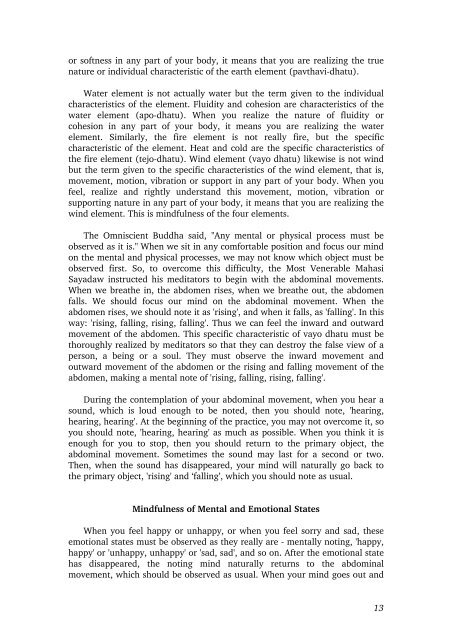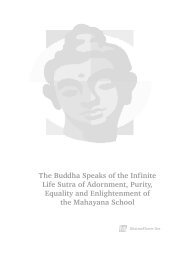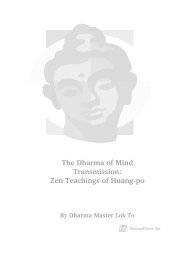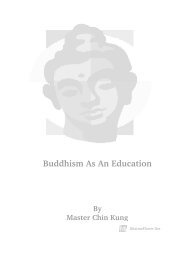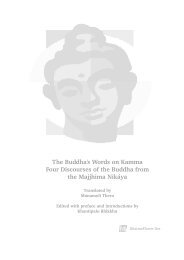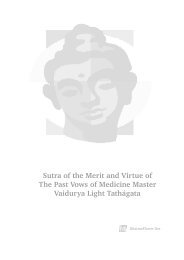Vipassana Meditation : Lectures On Insight Meditation by Venerable
Vipassana Meditation : Lectures On Insight Meditation by Venerable
Vipassana Meditation : Lectures On Insight Meditation by Venerable
Create successful ePaper yourself
Turn your PDF publications into a flip-book with our unique Google optimized e-Paper software.
or softness in any part of your body, it means that you are realizing the truenature or individual characteristic of the earth element (pavthavi-dhatu).Water element is not actually water but the term given to the individualcharacteristics of the element. Fluidity and cohesion are characteristics of thewater element (apo-dhatu). When you realize the nature of fluidity orcohesion in any part of your body, it means you are realizing the waterelement. Similarly, the fire element is not really fire, but the specificcharacteristic of the element. Heat and cold are the specific characteristics ofthe fire element (tejo-dhatu). Wind element (vayo dhatu) likewise is not windbut the term given to the specific characteristics of the wind element, that is,movement, motion, vibration or support in any part of your body. When youfeel, realize and rightly understand this movement, motion, vibration orsupporting nature in any part of your body, it means that you are realizing thewind element. This is mindfulness of the four elements.The Omniscient Buddha said, "Any mental or physical process must beobserved as it is." When we sit in any comfortable position and focus our mindon the mental and physical processes, we may not know which object must beobserved first. So, to overcome this difficulty, the Most <strong>Venerable</strong> MahasiSayadaw instructed his meditators to begin with the abdominal movements.When we breathe in, the abdomen rises, when we breathe out, the abdomenfalls. We should focus our mind on the abdominal movement. When theabdomen rises, we should note it as 'rising', and when it falls, as 'falling'. In thisway: 'rising, falling, rising, falling'. Thus we can feel the inward and outwardmovement of the abdomen. This specific characteristic of vayo dhatu must bethoroughly realized <strong>by</strong> meditators so that they can destroy the false view of aperson, a being or a soul. They must observe the inward movement andoutward movement of the abdomen or the rising and falling movement of theabdomen, making a mental note of 'rising, falling, rising, falling'.During the contemplation of your abdominal movement, when you hear asound, which is loud enough to be noted, then you should note, 'hearing,hearing, hearing'. At the beginning of the practice, you may not overcome it, soyou should note, 'hearing, hearing' as much as possible. When you think it isenough for you to stop, then you should return to the primary object, theabdominal movement. Sometimes the sound may last for a second or two.Then, when the sound has disappeared, your mind will naturally go back tothe primary object, 'rising' and ‘falling’, which you should note as usual.Mindfulness of Mental and Emotional StatesWhen you feel happy or unhappy, or when you feel sorry and sad, theseemotional states must be observed as they really are - mentally noting, 'happy,happy' or 'unhappy, unhappy' or 'sad, sad', and so on. After the emotional statehas disappeared, the noting mind naturally returns to the abdominalmovement, which should be observed as usual. When your mind goes out and13


